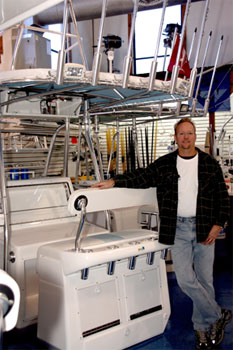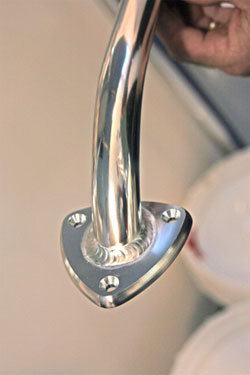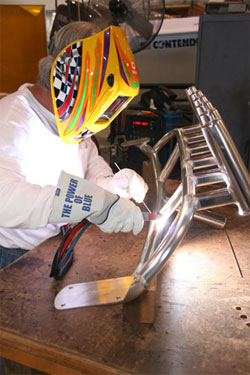Executive Summary:
- Welds that once took two passes are now completed in one – weld time is cut by 50 percent; overall production time reduced by one-third.
-
Dynasty TIG arc breaks through anodized coating and lowers heat input for less chance of warping/damage.
-
Dynasty 350 allows frequency to be adjusted anywhere from 20-400 Hz. Increasing the frequency produces a more focused arc with increased directional control, and a narrower bead and cleaning area.
-
Lower frequency softens the arc and results in a wider weld puddle and bead.
-
AC Balance Control adjusts balance between penetration and cleaning action portions of the wave.
-
Equipment payback resulting from increased productivity achieved in 6-7 months.
Birdsall Marine Rides The Perfect TIG Wave
Next Generation Of Advanced Squarewave Cuts Welding Time In Half,
What started off with Bob “Big Bob” Birdsall, Sr., building hot rod and boat components as a hobby more than 25 years ago has grown into Birdsall Marine Design, a 27-person company located in West Palm Beach, Fla. Today, Birdsall’s more than 100 distinctly crafted marine products adorn boats around the country. Boats owners from as far away as North Carolina and Puerto Rico bring their boats in to receive the Birdsall touch. Whether the boat is involved in competitive sport fishing or just used for weekend recreation, Birdsall has the products and skill to customize or restore it.
 |
The Dynasty 350 AC/DC TIG welder allows Bruce Saad, Birdsall fabrication manager, to weld the anodized aluminum in one pass instead of two.
|
“We manufacture different designs and perform all the fabrication that goes with our T-tops, leaning posts, towers, deck towers, rod holders, back rest arms and many other different items,” says Bobby Birdsall, Jr., company vice president. Birdsall even has its own in-house machine and upholstery shops, allowing them to perform all the tasks needed for custom jobs.
Birdsall uses anodized aluminum for its aluminum products, which make up about 85 percent of its products. Although anodized aluminum offers corrosion resistance and good appearance, it adds a level of complexity to the welding process, which until recently, doubled the welding time. With the introduction of a Dynasty 350 AC/DC TIG inverter from Miller Electric Mfg. Co. the job has become much easier and welding time has been cut in half.
No Second Chance
Anodizing, which closely resembles electroplating, converts the aluminum surface to aluminum oxide, which can vary from 0.0002 to 0.001 in. thick. This coating is hard, dense, and non-conductive. Unlike the rust on steel, aluminum oxide protects the base metal, providing increased corrosion resistance, excellent wear and abrasion properties, and a wide range of decorative finishes (color varies with the thickness of the coating).
However, aluminum oxide melts at approximately 3,600o F, while the aluminum underneath melts at about 1,200o F. Very few welding operators can develop a technique and find a machine that lets them manipulate the AC TIG arc so that it 1) penetrates the anodized coating and 2) establishes a good weld puddle without adding so much heat that the puddle rolls out of the joint or the arc blows through the base metal.
“When I first started welding, I was told you couldn’t weld anodized aluminum—that you had to remove the anodization first,” says Bruce Saad, Birdsall fabrication manager. Saad started using a technique called “backing around weld,” that allowed him to weld the material without first removing the coating. In backing around the weld, the operator first directs the torch in one direction to heat up the material and disperse the anodization to each side of the puddle. Then the operator makes a pass in the opposite direction to actually perform the weld.
This technique takes a skilled welder’s fine hand and doesn’t leave room for error. Too much heat can burn or warp the component and cause it to be scrapped.
 |
| The Dynasty 350 AC/DC TIG welder allows Bruce Saad, Birdsall fabrication manager, to weld the anodized aluminum in one pass instead of two.
|
“You get one chance to make a weld with anodized aluminum,” says Bob, Jr. “You can’t go back and sand it or do much else to it to make up for a bad weld. The appearance would suffer.”
To perform their jobs, Birdsall’s seven welder/fabricators use a variety of Miller TIG machines, from a 23-year-old AB/P 330 to a previous Dynasty model.
A Difficult Task Made Easier
When Saad was recently asked to test drive a new Miller Dynasty 350 AC/DC TIG/Stick welder, he found out how easy welding anodized aluminum could be. The new Dynasty allows him to make the weld in one pass not two. There is no longer any need to back around the weld. This saves 50 percent of the welding time and puts less heat into the weld, making it less likely to damage the component being welded. The ease with which the Dynasty accomplishes this makes it easier for a less skilled welder to make Birdsall quality welds (which in turn makes it easier to find new operators).
“I’ve used just about every Miller machine over the last 30 years and the Dynasty 350 is the best machine I’ve ever used,” Saad said. “It gives such a clean weld. It’s efficient. I no longer have to make two passes, so it’s cut down on my welding time. Since I’ve been using it, it’s been mostly one pass—good penetration, good strength—to create a clean, even-looking weld. It’s just been a pleasure to use.”
The secret is in the Dynasty 350’s waveform controls.
Advanced TIG Waveform Control
In conventional TIG welders, technology limits AC frequency to 50 or 60 HZ, the same as its single-phase input power. However, the Dynasty 350 is an inverter that eliminates the direct correlation to input power and allows frequency to be adjusted anywhere from 20 to 400 Hz. Increasing AC frequency provides a more focused arc with increased directional control and a narrower bead and cleaning area. A lower frequency softens the arc and results in a wider weld puddle and bead.
At 400 Hz the arc cone is much tighter and more focused than an arc cone operating at 60 Hz. (see photo)
 |
| The Dynasty 350 AC/DC TIG welder allows Bruce Saad, Birdsall fabrication manager, to weld the anodized aluminum in one pass instead of two.
|
AC Balance Control adjusts the balance between penetration (EN) and cleaning action (EP) portions of the wave. The Dynasty 350 allows the operator to set the amount of EN from 30 to 99 percent for greater control and fine-tuning of the cleaning action. A good weld only requires a.1-in. etched zone surrounding it. Using the least amount of cleaning action necessary helps maintain the tungsten point, reduces balling and provides for deeper, narrower penetration and creates a smaller heat affected zone.
The Dynasty 350 also allows the choice of four waveforms, depending specific requirements or operator preference: an advanced squarewave, which gives fast transitions for a responsive, dynamic and focused arc for better directional control, and a soft squarewave, which provides a smoother, softer arc with a more fluid puddle than the squarewave, plus a sine wave and a triangular wave (see sidebar).
Faster
Saad experimented with the Dynasty’s different settings, and found that a soft squarewave with an AC balance of 70 percent and frequency of 200 Hz works best for most of his work. The soft squarewave has the benefits of advanced squarewave, fine tuned to provide a smooth, soft arc with maximum puddle control and good wetting action. It’s ability to mimic the arc “feel” of older non-inverter TIG units, helps convert some operators to newer technology and the benefits it offers.
“I tried the AC frequency at different settings and found that by turning the AC frequency up, I get a tighter, crisper weld,” Saad says. “It cuts through the anodization better and eliminates the need for backing into the weld.”
Saad estimates that the Dynasty 350 cuts his welding time in half, which in turn, cuts production time by one third. For a TIG welder working eight hours a day and earning $20 to $25 an hour, that equals a weekly savings of $262 to $330, enough to pay for the unit in six to seven months.
Plus, the increased productivity allows Birdsall to get its products into its customers’ hands much sooner.
“With the Dynasty 350, I can get the job done faster,” Saad said. “That means the part goes to the riggers quicker and the parts fit better. The riggers can just take the parts and put them right on the boat without needing to perform adjustments. We get the boat out the door faster and the customer is happier because gets to play with his toy on the weekend.
 |
| With the Dynasty 350 AC/DC TIG welder, Bruce Saad, Birdsall fabrication manager, can tailor the TIG arc to meet his needs.
|
Better
The Dynasty 350’s advanced controls put less heat into the metal, almost eliminating the chance for burn through, distortion or warpage.
In addition, the Dynasty helps Saad create more cosmetically appealing welds, says Birdsall, who adds, “It’s a very crisp weld. Bruce [Saad] can make tighter, more petite and, therefore, more attractive welds. In this business and with our products, aesthetics is very important.”
Easier
“Since using the Dynasty 350, I’m a lot calmer at the end of the day,” says Saad, who was productive with the new unit within the first half hour. “Every position that I’ve had to get into, every different angle that I’ve had to use, the machine has performed flawlessly. There’s no hassle with the machinery and I’m very happy with my welds.”
With the shortage of welding operators sweeping the nation, this level of operator friendliness has made it easier for companies like Birdsall to ensure they can continue to provide high quality products to their customers.
“We’ve found that the Dynasty 350 makes it much easier to take a guy that doesn’t know how to weld anodized aluminum have him achieve a better looking weld,” says Birdsall. “Finding a trained welder is an ongoing challenge in today’s market. A machine like the Dynasty 350 allows us to find someone with a good work ethic, positive attitude and willingness to learn and teach him how to weld.”